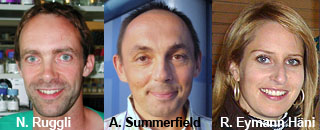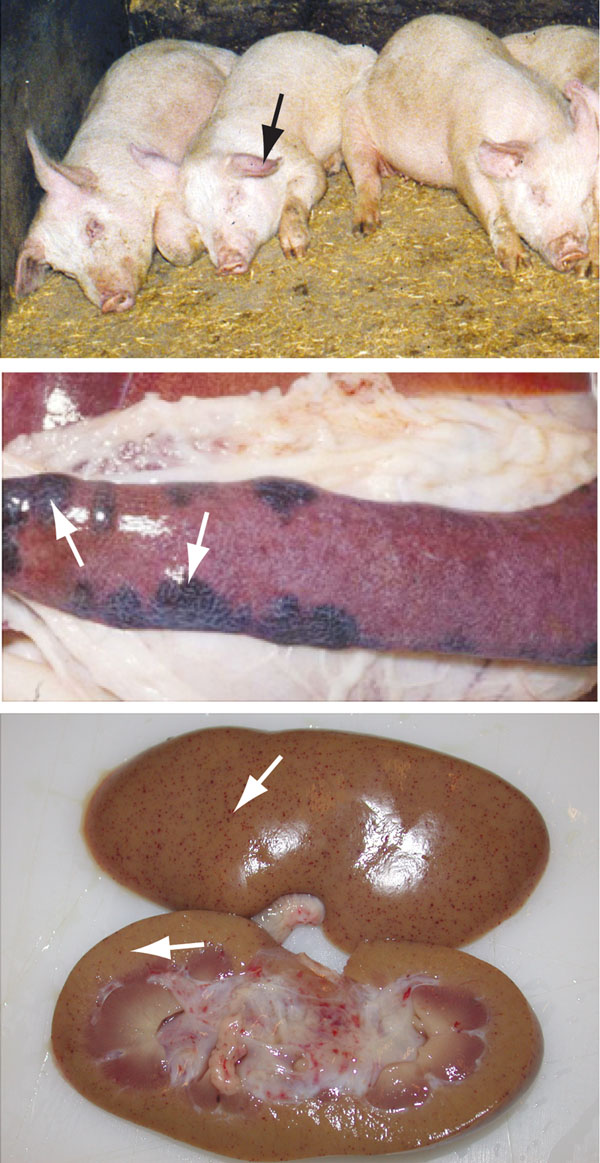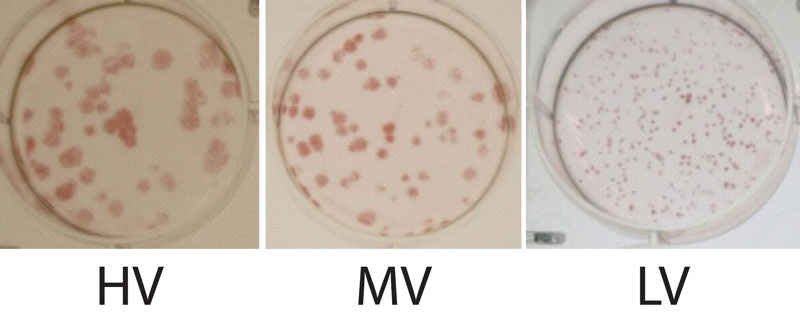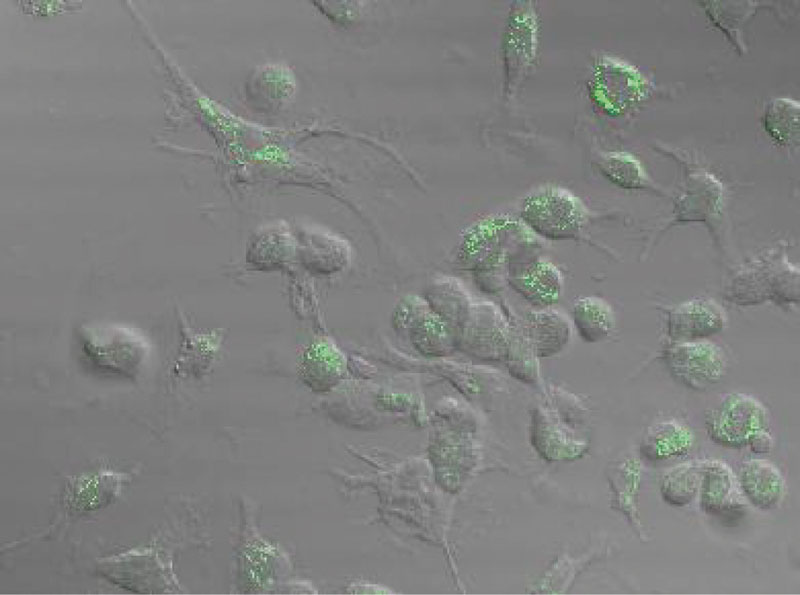 |
de | fr | en Druckansicht ![]()
3R-INFO-BULLETIN 44
October 2010
Authors

Taking advantage of their long-standing experience in CSF pathogenesis and porcine immunology, Dr. med. vet. Nicolas Ruggli (Deputy Head Virology, principle investigator 1) and PD Dr. med. vet. Artur Summerfield (Head Immunology, principle investigator 2) established an in vitro system to predict the degree of virulence for CSFV isolates. Dr. med. vet. Rita Eymann Häni performed the study and graduated from the Vetsuisse Faculty at the University of Berne, Switzerland.
Address:
Nicolas Ruggli
nicolas.ruggli@ivi.admin.ch
Artur Summerfield
artur.summerfield@ivi.admin.ch
Institute of Virology and Immunoprophylaxis (IVI)
Sensemattstrasse 293
CH-3147 Mittelhäusern
Switzerland
Rita Eymann Häni
rita.ehaeni@gmx.ch
present address: Cabinet Méd. Vétérinaire, Drs. Perrin & Surer, Au Châtelard, 1145 Bière, Switzerland.
Editor
Peter Maier, Scientific Adviser of the 3R Research Foundation
From pigs to cells: Virulence of classical swine fever virus is predictable in cell cultures
Classical swine fever (CSF)[*] is a highly contagious disease in pigs caused by CSF virus (CSFV). Information on virulence of an emerging isolate is crucial for guiding appropriate surveillance programs. The routine determination of the virulence of new CSFV isolates presents an ethical problem due to the necessity for infecting pigs. In the present project, funded by the 3R Research Foundation (Project No. 105-06), a cell-based in vitro system was developed which predicts the degree of virulence for CSFV isolates.
Virus propagation in vitro
Replication of RNA viruses is error-prone due to the lack of proof-reading of the viral RNA replication machinery. This results in genetic diversity and virus strains with varying degrees of virulence. Furthermore, amplification of viruses in permanent cell lines rapidly selects for cell culture-adapted viruses, as exemplified by enhanced binding to heparan sulphate (HS) glycosaminoglycans present on almost all vertebrate cells. Such viruses show altered replication characteristics in vitro and lower virulence in vivo, when compared with the original virus isolated from animals. Consequently, the first aim of this project was to identify a cell culture that does not select for virus mutants binding to HS glycosaminoglycans.
A suitable cell culture
By analysing several porcine primary cells and immortalized cell lines, we found that the porcine aortic endothelial cell line PEDSV.15 (Seebach J. D. et al., 2001) is suitable for the propagation of CSFV without altering the HS-binding properties of the virus (Eymann-Häni R. et al., submitted). With these cells, we amplified 17 prototype CSFV strains and field isolates with known virulence. These viruses served for systematic in vitro analyses aimed at identifying parameters that relate to virulence in vivo.
Understanding the disease for identifying in vitro parameters.
Recent advances in understanding the interaction of CSFV with the host led to a model for the pathogenesis of CSF, in which a specific role for different cells of the immune system was postulated (McCullough K. C. et al., 2009). After transmission via the oronasal route through direct contact or feeding of contaminated swill, the virus is found in the tonsils and oropharyngeal lymph nodes. It is transported via the blood stream to primary and secondary lymphoid tissues including the bone marrow, thymus, spleen, various lymph nodes, and gut-associated lymphoid tissue. The first detectable targets for CSFV infection and replication are endothelial cells, monocytes, macrophages and dendritic cells (DC). Importantly, the virus inhibits interferon regulatory factor 3 (IRF3)-dependent IFN-α/β production in these cells, by the means of Npro protein (Ruggli N. et al., 2005; Bauhofer O. et al., 2007). This leads to efficient replication, spread and rapid viremia. During viremia, the virus also infects plasmacytoid DC (pDC), also called natural interferon producing cells (NIPC). IFN-α production in these cells is IRF7-dependent, which is not impaired by Npro. Infection of pDC/NIPC leads to production of large quantities of IFN-α and pro-inflammatory cytokines. This cytokine storm is particularly strong with highly virulent strains, and leads to leukopenia and haemorrhagic immunopathology typical of CSF (Fig. 1) (Summerfield A. et al., 2006). Due to these characteristics, we focussed our attention on CSFV infection in endothelial cells, monocyte-derived macrophages, DC and pDC.

Fig. 1: CSFV causes a severe disease in pigs, with lameness and haemorrhages (top panel, arrow, outbreak Switzerland 1993), infarcts in the spleen (middle panel, arrows) and petechial bleedings in the kidney (bottom panel, arrows).
Three virulence parameters identified in vitro
The study determined the following three parameters as correlates for virulence.
Size of viral foci:
Highly virulent CSFV strains are known to show a more rapid onset of viremia and yield higher virus load than low virulent strains. We hypothesized that this may be reflected in the efficiency of a particular strain to spread within a cell culture that does not select for HS-binding mutants. This was analysed in terms of virus focus formation following infection of PEDSV.15 cells under a semi-solid medium overlay. Infection with the 17 prototype CSFV strains did indeed reveal that highly virulent strains form significantly larger foci of infected cells than moderately virulent and avirulent strains (an example is shown in Fig. 2).

Fig. 2: Assessment of viral spread by a focus size assay. PEDSV.15 cells were infected with a highly virulent (HV), a moderately virulent (MV) and a low virulent (LV) CSFV and incubated under a semi-solid agarose/medium overlay. The foci of infected cells were visualized with immunoperoxidase-staining for the viral glycoprotein E2.
Infection of macrophages:
We also investigated the replication characteristics of the 17 prototype CSFV strains in porcine monocytes, macrophages and DC, infected ex vivo in presence or absence of different cytokines to mimic in vivo conditions. In these cells, in particular the activated macrophages, highly virulent strains resulted in a higher percentage of infected cells compared to moderately virulent and avirulent strains. The intensity of staining for the viral NS3 protein in the infected cells was also higher with highly virulent than with avirulent strains (CSFV-infected porcine macrophages and DC are shown in Fig. 3).

Fig. 3: Porcine macrophages and DC infected with CSFV. The cells were fixed and viral NS3 protein (green) was visualized by immunofluorescence-based microscopy.
IFN-α production in pDC:
During the acute phase of CSFV infection in pigs, we observed a correlation between the virulence of the strain and the level of circulating IFN-α (Summerfield A. et al., 2006). In vivo, the cells known to produce large quantities of IFN-α are porcine pDC (Summerfield A. and McCullough K. C., 2009). With the prototype CSFV used in this study, we observed that pDC produce more IFN-α upon infection with highly virulent than with less virulent strains.
The three parameters considered together
Importantly, our results show that the prediction of virulence cannot rely on a single assay. Given the complexity of the disease in the context of a whole organism, it is conceivable that reliable prediction of virulence in vitro requires several different parameters to be assessed. In order to predict the virulence of a CSFV isolate of interest, the three in vitro parameters must be considered together. Only if the three parameters reveal the same virulence status, is there a high probability that the prediction is correct.
Stimuli for applications in diagnostics and fundamental research
Assessment of viral virulence through in vivo infection experiments is currently a routine procedure to study pathogenesis of a viral disease, and to monitor the virulence of emerging virus isolates. With moderately to highly virulent viruses, the burden for the animals is high. Although a full validation of our proposed in vitro system is required with a larger number of CSFV isolates, the system opens up new perspectives for the assessment of CSFV virulence without the systematic need for animal trials. Application in both diagnostic and research fields will considerably reduce the number of infection experiments with pigs. This system will also permit a controlled analysis of genetic determinants of virulence, and may prove applicable for other viruses
PDF version of this Bulletin No. 44
References:
- Bauhofer, O., A. Summerfield, Y. Sakoda, J.- D. Tratschin, M. A. Hofmann, and N. Ruggli. 2007. Classical swine fever virus Npro interacts with interferon regulatory factor 3 and induces its proteasomal degradation. J. Virol. 81:3087-3096.
- Eymann-Häni, R., A. Summerfield, K. C. McCullough, and N. Ruggli. Classical swine fever virus propagation in vitro circumventing heparan sulfate-adaptation. Submitted for publication.
- McCullough, K. C., N. Ruggli, and A. Summerfield. 2009. Dendritic cells--at the front-line of pathogen attack. Vet. Immunol. Immunopathol. 128:7-15.
- Ruggli, N., B. H. Bird, L. Liu, O. Bauhofer, J.-D. Tratschin, and M. A. Hofmann. 2005. Npro of classical swine fever virus is an antagonist of double-stranded RNA-mediated apoptosis and IFN-alpha/beta induction. Virology 340:265-276.
- Seebach, J. D., M. K. Schneider, C. A. Comrack, A. LeGuern, S. A. Kolb, P. A. Knolle, S. Germana, H. DerSimonian, C. LeGuern, and D. H. Sachs. 2001. Immortalized bone-marrow derived pig endothelial cells. Xenotransplantation 8:48-61.
- Summerfield, A., M. Alves, N. Ruggli, M. G. de Bruin, and K. C. McCullough. 2006. High IFN-alpha responses associated with depletion of lymphocytes and natural IFN-producing cells during classical swine fever. J. Interferon Cytokine Res. 26:248-255.
- Summerfield, A., and K. C. McCullough 2009. The porcine dendritic cell family. Dev. Comp. Immunol. 33:299-309.
| [*] | CSF: a continuous threatIn Switzerland, the last CSF outbreak in domestic pigs occurred in 1993 (Fig. 1) and the virus was reported for the last time in wild boar in 1999. However, re-emergence of CSFV represents a constant threat for pig farming. Indeed, the world organisation for animal health (OIE) regularly registers new cases of CSF worldwide, including Europe. In Bulgaria, Slovakia, Hungary and Russia the virus still circulates and results in clinical disease (for the current disease situation, see http://www.oie.int/wahis/public.php?page=home). The wild boar – the natural CSFV reservoir – and the extension of the European community to eastern European countries, along with reduced controls at the borders, elevate the risk of re-introducing the disease in Switzerland through the import of contaminated wild boar or pork meat products. A CSFV outbreak in the domestic pig would generate significant economic losses and restrictions in the meat trade. In domestic pigs as well as in wild boar, CSFV can manifest various degrees of virulence, from avirulent to highly virulent. Low and moderately virulent strains result in a mild, atypical, often chronic disease, and induce a protective immunity. This contrasts with highly virulent strains that cause acute to peracute symptoms consisting of high fever, diarrhoea, lameness and haemorrhages (Fig.1). Such disease rapidly progresses within a herd with a high mortality rate, irrespective of the age and weight of the infected pigs. Accordingly, information on the virulence of an emerging isolate is crucial for guiding the implementation of appropriate surveillance programs and control measures. The experimental infection of pigs is currently the only possibility of classifying the virulence of a CSFV isolate. Such animal experiments are of moderate to high severity, depending on the virulence of the isolate. The present project opens new perspectives to reduce the number of pigs used in CSF diagnostics and research. Abbreviations used: |
| Letzte Änderung: 16.09.2010 |